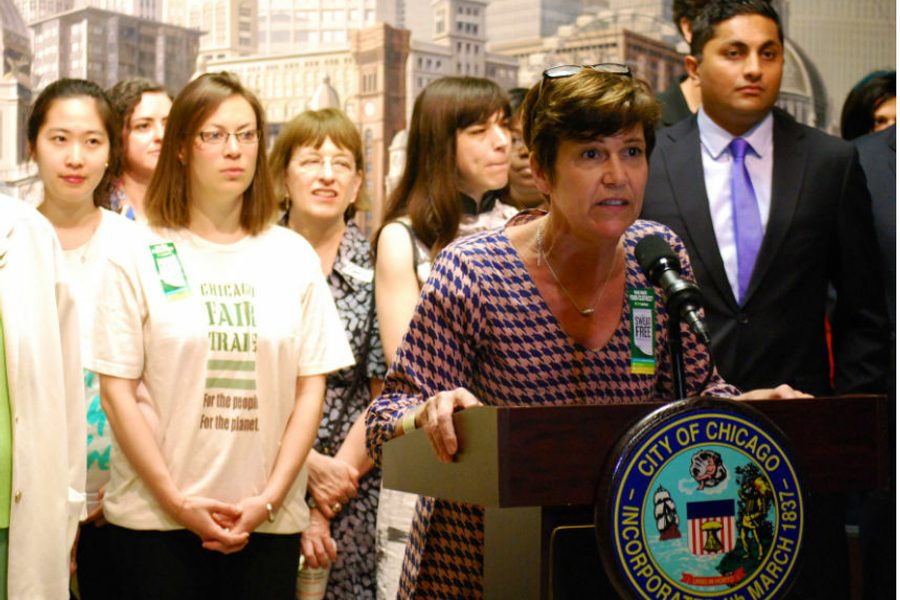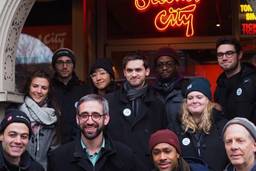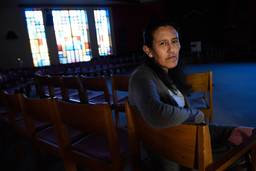
When Chicago’s firefighters, police officers and maintenance personnel put on their uniforms each morning before going to work, they do so under union contracts that govern their safety and working conditions. But the people who make those same uniforms are unlikely to have any protections from the wage theft, locked fire exit doors and precarious buildings they could be facing on the job.
A new ordinance introduced in the Chicago City Council on May 28 aims to fix that inconsistency. If the ordinance is passed, Chicago will join Los Angeles, St. Louis, Milwaukee, Boston and Seattle in attempting to enforce labor rights for factory workers despite the layers of contracting and sub-contracting typical for the garment industry.
Drafted by Chicago Fair Trade as part of Sweatfree Communities, a national campaign against government purchase of supplies made by sweatshop labor, the ordinance would mandate that the city only buy employee garments from companies who sign an affidavit promising that neither they nor their sub-contractors would use sweatshop labor. The companies would also have to disclose their supply chains for the production of the clothing.
“All of us here today claim an important role in the global economy. The consumer choices we make here in Chicago reverberate and shape the lives of workers and producers around the world,” said Katherine Bissell-Cordova, executive director of Chicago Fair Trade, at a Wednesday press conference introducing the ordinance. “Each year, the city of Chicago spends millions of our tax dollars on uniforms. As it stands, we don’t know where these uniforms are produced.”
The ordinance comes on the heels of the one-year anniversary of the Rana Plaza factory disaster, in which a shoddily made building manufacturing clothes for several global brands collapsed, killing more than 1,134 people and injuring more than 2,500 others. The accident sparked international outrage and calls to improve the industry, including from American federal officials. Eight months later, however, a New York Times investigation revealed that the U.S. government itself spends more than $1.5 billion a year on supplies from overseas companies. Conditions are abysmal in many of these factories, with padlocked fire exits and illlegal building additions among the dangers workers face.
Overall, Chicago Fair Trade estimates that more than $10 billion is spent annually on what it calls “unethical apparel” by U.S. federal, state and local governments.
The ordinance introduced Wednesday is certainly an admirable first step in combating such abuses. What’s missing, though, is the aspect of oversight. Unlike the Chicago fair trade resolution passed in 2011, the sweatshop ordinance is meant to be binding. However, its application will depend on resources put toward enforcement by the city.
Although the ordinance notes the city’s chief procurement officer will be responsible for adopting rules around its administration, Bissell-Cordova says she hopes Chicago will join the Sweatfree Purchasing Consortium, a coalition of public municipalities across the country. The consortium lists ethical apparel suppliers and offers an anonymous reporting mechanism for workers whose factories produce for public entities. Among the services offered to members are tools allowing municipalities to investigate alleged sweatshops.
However, the draft of the ordinance introduced Wednesday doesn’t include Consortium membership in its text. According to Bissell-Cordova, that’s because it was removed by legislators before it was presented to the City Council. “We are going to work our hardest to get it back in before it’s passed,” she says.
As it stands, the ordinance has support from both the Council’s Progressive Caucus and the Latino Caucus.
When it comes to putting the ordinance into effect, Chicago could take its cue from Los Angeles. L.A.‘s anti-sweatshop law, which was passed in 2004, designates funding for one city enforcement officer, an independent monitor and an oversight committee that includes advocates. It also requires any government supply contractors to pay their workers a living wage; in the 10 years it has been in place, the team has helped uncover 50 different factory sites abroad with labor abuses.
But not all cities have been as successful. San Francisco passed a similar ordinance in 2005, but in 2007 the City Council brought it up again for a vote, saying a lack of manufacturers willing to comply with the increased regulations made it difficult to find contractors. Instead, the city opted to obtain its uniforms under five-year exemptions for participating contractors, a practice anti-sweatshop activists called out for not looking hard enough for ethical suppliers.
Meanwhile, companies that have been connected to clothes produced at Rana Plaza but whose production is not restricted under the ordinance continue to do business with the city. A Walmart on the city’s South Side, which made its way into Chicago despite protests against its labor record, was subsidized with millions in public dollars; Mayor Rahm Emanuel attended its ribbon-cutting.
Bissell-Cordova acknowledges that while she’d like to see all companies who use sweatshop labor held accountable, passing the ordinance will be a good start. “We certainly have long-term goals of how the city should be, but this [ordinance] is the first step in institutionalizing some of our goals for ethical purchasing,” she says.







